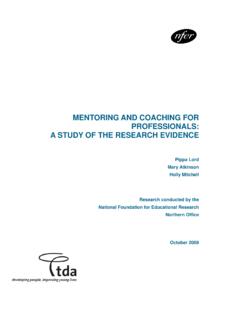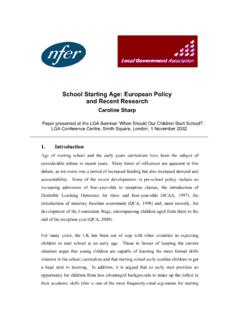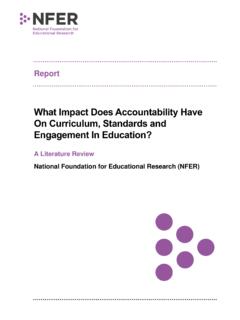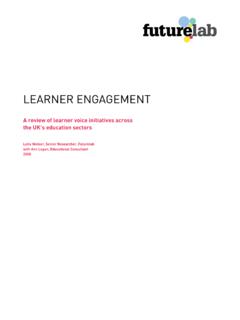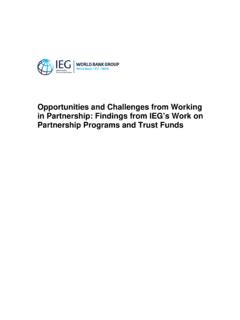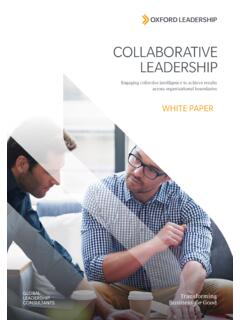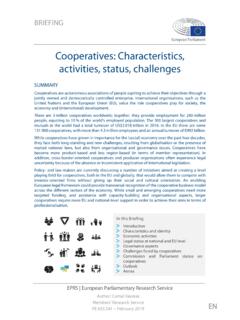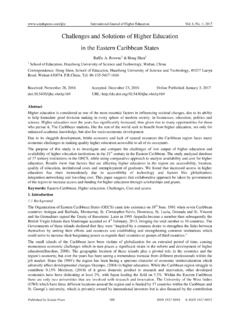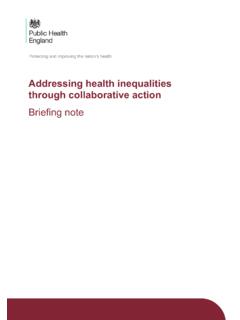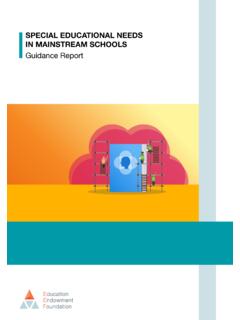Transcription of Multi-agency working: a detailed study - NFER
1 Multi-agency working :a detailed studyMary AtkinsonAnne WilkinAlison StottPaul DohertyandKay KinderPublished in January 2002by the National Foundation for Educational Research,The Mere, Upton Park, Slough, Berkshire SL1 2DQ National Foundation for Educational Research 2001 Registered Charity No. 313392 ISBN 1 903880 13 0 CONTENTSA cknowledgementsiExecutive summaryiiIntroduction1 Literature review31. Different types of Multi-agency Decision-making Consultation and Centre-based Coordinated Operational-team delivery202. Rationale and Rationale behind Multi-agency Processes involved in Stages of development433. Professional and agency Professional How professionals came to be Extent of Multi-agency activity prior to the How agencies came to be involved744. Roles and Determination of roles and Roles and responsibilities: a general The range of roles and responsibilities835.
2 Impact on the target Impact on Impact on individual Impact on general Multi-agency activity1076. Key challenges to Multi-agency Fiscal Roles and Competing Non-fiscal Professional and agency Other challenges1357. Key factors and skills for Multi-agency Commitment or willingness to be Understanding roles and Common aims and Communication and information Leadership or Involving the relevant Sharing and access to funding and Other key factors1588. Case studies162 Case study 1165 Case study 2175 Case study 3184 Case study 4194 Case study 5205 Case study 6214 Concluding comments225 References226 ACKNOWLEDGEMENTSiThe authors would like to thank the staff from the different agencies withineach of the initiatives visited who gave up their time to take part in theinterviews. Their perspectives provided valuable data for this phase of thestudy.
3 We are particularly grateful for the contributions of initiative staffand representatives of other agencies within the six authorities that agreedto act as case studies for the are very grateful to Michelle Robinson and Phil Craig for reading andcommenting on drafts of this report. Thanks are also due to our colleaguesat NFER: Sally Kendall, for acting as our internal reader; David Upton, forhis editorial input; Simon Rutt for statistical input; Mary Hargeaves for hercontribution to the final document and lastly, for secretarial supportthroughout the project, Hilary McElderry and Sue working : A detailed STUDYEXECUTIVE SUMMARYB ackgroundThis report relays the findings from the final phases of a study of Multi-agency working involving professionals from the Education, Social Servicesand Health sectors of local research study comprised three phases (Phase One was described inthe interim report, Multi-agency working : an Audit of Activity).
4 DuringPhase Two of the study , 30 Multi-agency initiatives were selected and visitedfor the purpose of interviewing key individuals from each of the participatingagencies resulting in a total of 139 interviews. Six of these initiativeswere then visited again for a more detailed case- study analysis andobservation during Phase report includes analysis and discussion of the different types, or models,of Multi-agency activity; the rationale for their development; agencies andindividuals involvement in Multi-agency activities, their roles andprofessional backgrounds; the impact of Multi-agency activities; and thechallenges and key factors in their types of Multi-agency activity Five different models of Multi-agency activity were evident withinthe sample: decision-making groups; consultation and training; centre-based delivery; coordinated delivery; and operational-team , some models focused on direct delivery to a range of targetgroups, whilst in others the primary aim or purpose was decision-making or providing consultation and training to other agencies.
5 Agencies came together for different reasons and, for each of thedifferent models, different levels of engagement with professionalsfrom other agencies were evident. A continuum may be describedfrom decision-making groups, where professionals from differentagencies maintained their distinct role, to operational teams, whereprofessionals worked closely in close proximity and therefore themerging of roles was more and development Although a variety of rationales and aims for Multi-agency workingwere presented, the aims centred on three main areas: improvingservices, outcomes for children and families and Multi-agency SUMMARYW hilst some aims were common to all Multi-agency activity, somewere specific to particular types. Differences emerged in the way in which professionals judged whatwas considered to be established and what was not, such as whereindividual agencies still felt there were issues for them that needed tobe addressed.
6 These may provide some useful pointers to theprogression of Multi-agency work in the future. Whilst the appointment of key staff, gaining the commitment ofagencies and consultation were felt to be key processes in development,difficulties in these areas in the early stages were also and professional involvement The background to the Multi-agency initiatives set up clearly variedenormously both in terms of the personal backgrounds of thoseinvolved, and the context of agency relationships within the also described a range of ways in which both individualprofessionals and agencies became involved in Multi-agency work. Interviewees described their own backgrounds in terms of having awide range of training and qualifications, and a wide range of roleswithin a variety of different agencies. Over a third of those involvedin the initiatives under study had worked in multiple agencies duringtheir career, indicating this as a beneficial experience for multi -agencyworking.
7 The background contexts of the different authorities clearly variedconsiderably from area to area in terms of interviewees perceptionsof the general Multi-agency working and relationships which existedprior to the initiative, and their perceptions of the relationships betweenspecific agencies. Different traditions of interagency relations wereevident in each of the and responsibilities Conflicting views, however, arose about whether roles were determinedprimarily by the skills and expertise of the professionals involved orwhether this was secondary to the personal qualities of individuals. Roles and responsibilities generally undertaken in Multi-agency workwere, according to interviewees, the Multi-agency steering ormanagement group, which was a key phenomenon in all types of Multi-agency activity, the shared responsibility between the agencies involvedand an overlap or merging of roles. An overlap or a merging of rolesindicated that boundaries between the agencies had become blurred,and in the main this was felt to have been beneficial.
8 However,others felt that maintaining distinct roles was crucial in allowingindividual agencies to make a valuable and unique contribution tomulti- agency SCHOOL SELF-EVALUATION A wide range of roles and responsibilities was felt to be involved inmulti- agency working and those identified suggested that a complexhierarchy of roles and responsibilities may exist, for example, at thelevel of the initiative itself, at an interagency level and at the level ofindividual agencies. Professionals working in collaboration with otheragencies therefore have to balance differing roles and responsibilitiesat all these different A wide range of direct benefits of working in a Multi-agency way wasidentified for children and their families. These centred on three mainareas: improved services, direct outcomes and prevention. Improvedaccess to services was commonly highlighted, as well as animprovement in children s educational attainment and their access toeducation.
9 This points to the contribution that other agencies can maketo children s education. For the agencies involved, the advantages of Multi-agency work centredon offering them a broader perspective, a better understanding of theissues, and increased understanding of, and improved interactions with,other agencies. However, whilst it was sometimes felt to raise theirprofile, it was also commonly reported to create increased demandsand pressures on individual agencies. For the individual professionals involved, on the one hand, workingwith professionals from other backgrounds was rewarding andstimulating. On the other, it often led to increased work or commonly reported that their work alongside other professionalsgave them a broad perspective and raised their awareness of theoperation of other The challenges identified in association with Multi-agency workingwere numerous and reflected the complexities involved whenprofessionals engage in collaborative ventures.
10 The issues involved,however, centred broadly around the areas of funding and resources,roles and responsibilities, competing priorities, communication,professional and agency cultures and management. Perhaps not surprisingly, issues around funding were the most oftencited challenges , not only generally, but also in the early stages ofdevelopment of projects. challenges involved conflicts over fundingwithin and between agencies, a general lack of funding for multi -agencywork and concerns about sustainability. This was the case regardlessof the type of Multi-agency activity. Other types of resources werealso an issue: Multi-agency work being cited in some cases to beparticularly demanding of staff, time and accommodation, comparedto a single agency SUMMARY Communication was identified as a challenge at all levels of working ,although different interpretations of the problem were evident atstrategic and operational level.

